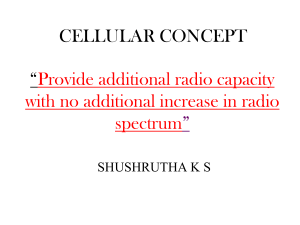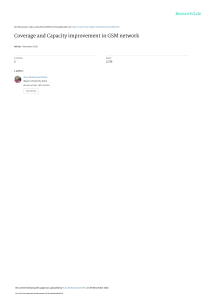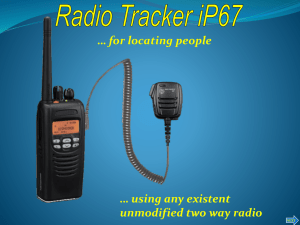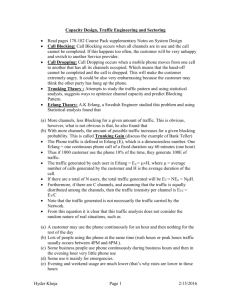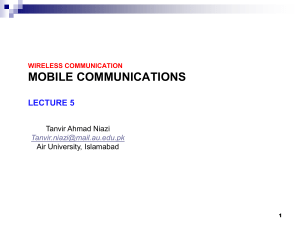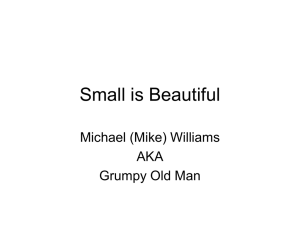Lecture6(Trunking and Grade of Service)
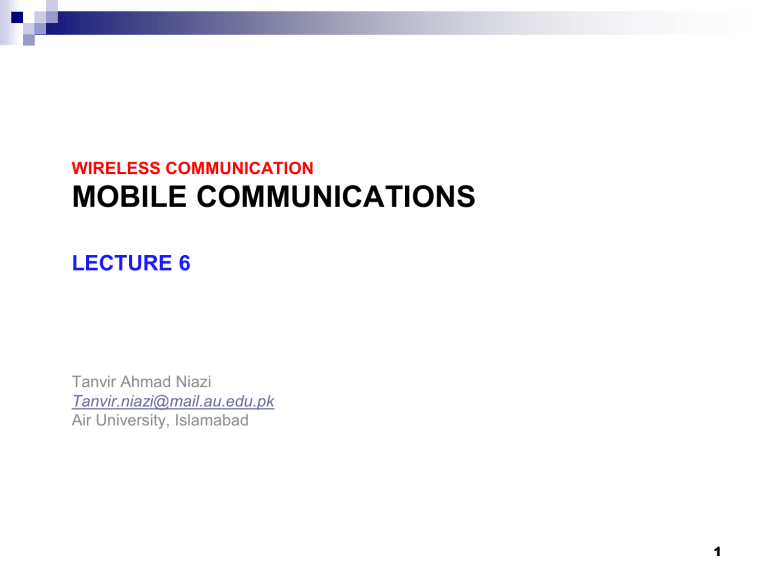
WIRELESS COMMUNICATION
MOBILE COMMUNICATIONS
LECTURE 6
Tanvir Ahmad Niazi
Tanvir.niazi@mail.au.edu.pk
Air University, Islamabad
1
Overview of the Previous Lecture
New Topics
Trunking and Grade of Service
Improving Coverage and Capacity in Cellular Systems
Announcements
2
Overview of the Previous Lecture
Channel Assignment Strategies
--Fixed, Dynamic, Channel borrowing
Hand off Strategies
--Prioritizing Handoffs
--Practical Handoff Considerations
Interference and System Capacity
--Co-channel interference and System capacity
--Channel Planning for Wireless Systems
--Adjacent Channel Interference
--Power Control for Reducing Interference
3
Adjacent Channel Interference
Interference from channels that are adjacent in frequency,
The primary reason for that is Imperfect Receive Filters which cause the adjacent channel energy to leak into your spectrum.
Problem is severer if the user of adjacent channel is in close proximity.
Near-Far Effect
Near-Far Effect: The other transmitter(who may or may not be of the same type) captures the receiver of the subscriber.
Also, when a Mobile Station close to the Base Station transmits on a channel close to the one being used by a weaker mobile: The BS faces difficulty in discriminating the desired mobile user from the “bleed over” of the adjacent channel mobile.
4
Near-Far Effect: Case 1
The Mobile receiver is captured by the unintended, unknown transmitter, instead of the desired base station
5
Near-Far Effect: Case 2
The Base Station faces difficulty in recognizing the actual mobile user, when the adjacent channel bleed over is too high.
6
Minimization of ACI
(1) Careful Filtering ---- min. leakage or sharp transition
(2) Better Channel Assignment Strategy
Channels in a cell need not be adjacent: For channels within a cell, Keep frequency separation as large as possible.
Sequentially assigning cells the successive frequency channels.
Also, secondary level of interference can be reduced by not assigning adjacent channels to neighboring cells.
For tolerable ACI, we either need to increase the frequency separation or reduce the passband BW.
7
Trunking and Grade of
Service (GOS
)
8
Trunking and Grade of Service
(GOS)
Trunking:
A means for providing access to users on demand from available pool of channels.
With trunking, a small number of channels can accommodate large number of random users.
Telephone companies use trunking theory to determine number of circuits required.
Trunking theory is about how a population can be handled by a limited number of servers.
9
Terminology:
3.
4.
5.
6.
7.
1.
2.
Traffic intensity is measured in Erlangs:
One Erlang: traffic in a channel completely occupied. 0.5 Erlang: channel occupied 30 minutes in an hour.
Grade of Service (GOS): probability that a call is blocked (or delayed).
Set-Up Time: time to allocate a channel.
Blocked Call: Call that cannot be completed at time of request due to congestion. Also referred to as Lost Call.
Holding Time: (H) average duration of typical call.
Load: Traffic intensity across the whole system.
Request Rate: (λ) average number of call requests per unit time.
10
Traffic Measurement (Erlangs)
11
12
Tahir Iqbal, Air University
13
14
15
16
17
18
Erlang C Model –Blocked calls cleared
A different type of trunked system queues blocked calls –Blocked Calls
Delayed. This is known as an Erlang C model.
Procedure:
Determine Pr[delay> 0] = probability of a delay from the chart.
Pr[delay > t | delay > 0 ] = probability that the delay is longer than t, given that there is a delay
Pr[delay > t | delay > 0 ] =exp[-(C-A)t /H ]
Unconditional Probability of delay > t :
Pr[delay > t ] = Pr[delay > 0] Pr[delay > t | delay > 0 ]
Average delay time D = Pr[delay > 0] H/ (C-A)
19
Erlang C Formula
The likelihood of a call not having immediate access to a channel is determined by Erlang C formula:
20
Tahir Iqbal, Air University
21
22
23
Improving Capacity in Cellular
Systems
Cost of a cellular network is proportional to the number of Base Stations.
The income is proportional to the number of users.
Ways to increase capacity:
New spectrum –expensive. PCS bands were sold for $20B.
Architectural approaches: cell splitting, cell sectoring, reuse partitioning, microcell zones.
Dynamic allocation of channels according to load in the cell (non-uniform distribution of channels).
Improve access technologies. 3.7 Improving Capacity in Cellular Systems
24
Cell Splitting
Cell Splitting is the process of subdividing the congested cell into smaller cells (microcells),Each with its own base station and a corresponding reduction in antenna height and transmitter power.
Cell Splitting increases the capacity since it increases the number of times the channels are reused.
25
An Example
The area covered by a circle with radius R is four times the area covered by the circle with radius R/2
The number of cells is increased four times
The number of clusters the number of channels and the capacity in the coverage area are increased
Cell Splitting does not change the co-channel re-use ratio Q =D/R
26
Transmit Power
New cells are smaller, so the transmit power of the new cells must be reduced
How to determine the transmit power?
The transmit power of the new cells can be found by examining the received power at the new and old cell boundaries and setting them equal
Pr(at the old cell boundary) is proportional to
Pr(at the new cell boundary) is proportional to
27
Transmit Power
28
Application of cell splitting
Not all cells are split at the same time.
Larger transmit power
Some of the channels would not be sufficiently separated from the cochannel cells.
Smaller transmit power --parts of the larger cells left uncovered
Two groups:
one that corresponds to the smaller cell and the other for larger cell reuse requirements
29
Application of cell splitting
(cont.)
The sizes of these two groups depend on the stage of the splitting process
At the beginning, fewer channels will be there in the smaller power group.
As the demand grows, smaller groups would require more channels
Cell splitting continues until all the channels are in the smaller power group
Antenna Down tilting
To limit the radio coverage of microcells
30
Cell Overlay
It’s a relatively novel technique
Cells used by A are divided into:
Channels used by ‘a’ –those are used by ‘A’ only within radius R/2 from center.
Channels not used by ‘a’ –no restrictions on their use in A.
31
Cell sectoring
Another way to reduce the number of cells in a cluster and hence, to reduce Interference is sectoring. Sectoring refers to the use of directional rather than omni antennas. Three (3) 120 degrees sectors are shown as an example
Analysis: mobile in center cell will experience interference from only 2 cells (not 6).
Improvement of 6dB in S/I. Alternatively, try to reduce the reuse factor. Sectoring entails reduced trunking efficiency.
32
33
Tahir Iqbal, Air University
34
Example of Cell Sectoring
With omin directional antennas
Where we assumed that the power attenuation n = 4.
For N = 4, we obtain S = 13.8 dB.
For N = 4 and with 3 sectors, we get S = 19. 9 dB:
35
Microzones
Multiple zones and a base station make up a cell
As a mobile travels within the cell, it is served by the zone with the strongest signal
This technique is superior to sectoring because antennas are placed at the outer edges of the cell, and any base station channel can be assigned to any zone by the base station
36
Microzoning
37
ADVANTAGES
No handoffs is required at the MSC
The base station radiation is localized and interference is reduced. A given channel is active only in the particular zone in which the mobile is traveling
The co-channel interference is also reduced
38
Decreased co-channel interference improves signal quality which leads to an increase in capacity without any degradation in trunking efficiency caused by sectoring
For example
We know an (S/I) of 18dB is required for satisfactory system performance in narrowband FM
39
EXAMPLE
If a system with N=7 and (D/R)=4.6,it can achieved a (S/I) of 18dB
For a microcell zone system, since transmission at any instant is confined to a particular zone, this implies that a (Dz/Rz) of 4.6 can achieve the required performance where,
Dz = minimum distance between active co-channel zones and
Rz = zone radius
40
41
EXAMPLE
(cont.)
42
43
Repeaters for Range Extension
Repeaters are radio re-transmitters used to provide coverage for hard-toreach areas, such as within buildings or in valleys or tunnels
Repeaters are bidirectional. Upon receiving signals from base station, then amplifies and reradiates the base station signals to the specific coverage region. Also it will send signals to the serving base station.
The repeaters do not add capacity to the system-it simply serves to reradiate the base station signal into specific locations
44
Repeaters for Range Extension
45
Summary for chapter 3
Concepts of handoff, frequency reuse, trunking efficiency and frequency planning have been presented
The capacity of a cellular system depends on several factors and the methods to increase the capacity
The overriding objective of these methods is to increase the number of users in the system
46
Announcements
Problems:
1.3, 1.13, 1.9, 1.10 and 1.18
Problems:
3.1, 3.2, 3.4, 3.5 and 3.8
Due date
14 th March, 2008
47

